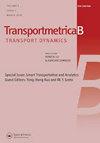Recalibration of the BPR function for the strategic modelling of connected and autonomous vehicles
IF 3.4
2区 工程技术
Q2 TRANSPORTATION
引用次数: 4
Abstract
This paper assesses the adequacy of the BPR volume delay function for the strategic modelling of Connected and Autonomous Vehicles (CAVs). Three testbed environments are simulated at 10% increments of CAV penetration rates (CPR) to observe network performance in mixed fleet environments. The microsimulation dataset is compared with the BPR travel time predictions to evaluate the need for recalibration. Where appropriate, the BPR modelling parameters are redefined as a function of the CPR. The predictive quality of the recalibrated model is then validated by comparing it against the BPR function on synthetic data. The numerical results indicate an overall improvement in travel time prediction using the recalibrated model, with a significant reduction in root mean square error from 15.16 to 8.86. The recalibrated model also outperformed the traditional BPR model in 67% of the 4620 cases used for validation, and better-predicted travel time by 5.43 times.为联网和自动驾驶汽车的战略建模重新校准BPR功能
本文评估了BPR体积延迟函数在联网和自动驾驶汽车(cav)战略建模中的充分性。以10%的CAV渗透率(CPR)增量模拟了三个测试平台环境,以观察混合车队环境下的网络性能。将微模拟数据集与BPR行程时间预测进行比较,以评估重新校准的必要性。在适当的情况下,业务流程再造模型参数会根据业务流程再造的功能重新定义。通过与合成数据上的BPR函数进行比较,验证了重新校准模型的预测质量。数值结果表明,使用重新校准的模型对旅行时间的预测总体上有所改善,均方根误差从15.16显著降低到8.86。在用于验证的4620个案例中,重新校准的模型在67%的情况下优于传统的BPR模型,并且更好地预测了5.43倍的旅行时间。
本文章由计算机程序翻译,如有差异,请以英文原文为准。
求助全文
约1分钟内获得全文
求助全文
来源期刊

Transportmetrica B-Transport Dynamics
TRANSPORTATION SCIENCE & TECHNOLOGY-
CiteScore
5.00
自引率
21.40%
发文量
53
期刊介绍:
Transportmetrica B is an international journal that aims to bring together contributions of advanced research in understanding and practical experience in handling the dynamic aspects of transport systems and behavior, and hence the sub-title is set as “Transport Dynamics”.
Transport dynamics can be considered from various scales and scopes ranging from dynamics in traffic flow, travel behavior (e.g. learning process), logistics, transport policy, to traffic control. Thus, the journal welcomes research papers that address transport dynamics from a broad perspective, ranging from theoretical studies to empirical analysis of transport systems or behavior based on actual data.
The scope of Transportmetrica B includes, but is not limited to, the following: dynamic traffic assignment, dynamic transit assignment, dynamic activity-based modeling, applications of system dynamics in transport planning, logistics planning and optimization, traffic flow analysis, dynamic programming in transport modeling and optimization, traffic control, land-use and transport dynamics, day-to-day learning process (model and behavioral studies), time-series analysis of transport data and demand, traffic emission modeling, time-dependent transport policy analysis, transportation network reliability and vulnerability, simulation of traffic system and travel behavior, longitudinal analysis of traveler behavior, etc.
 求助内容:
求助内容: 应助结果提醒方式:
应助结果提醒方式:


